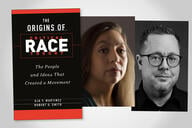You have /5 articles left.
Sign up for a free account or log in.
In No Study Without Struggle: Confronting Settler Colonialism in Higher Education (Beacon Press), Leigh Patel reviews (briefly) the entire history of American higher education and the impact of settler colonialism on the sector. She also features interviews with activists from the Black Lives Matter movement and others pushing for real change in the United States.
Patel, a professor at the University of Pittsburgh, responded to questions about her book via email.
Q: How is settler colonialism present in higher education today? How is the racism experienced by students linked to settler colonialism?
A: Higher education is, as Craig Steven Wilder points out, the third pillar of the United States, alongside church and state. As an arm of the state, it is closely connected to how the nation was formed, rose to wealth and maintains its core structure as a settler colony. This means many things for higher education. A settler colony is one established through the seizure of land, the attempt to erase indigeneity and the use of chattel slavery to bolster both property and free labor that was crucial to the wealth made from crops.
Today, settler colonialism is enlivened through campuses that sit upon still Indigenous lands, often through federal mandates and broken treaties with Native nations and tribes. The nation’s ideologies of meritocracy and individualism -- if one works hard, is a good person, and plays by the rules, is the promise of upward social mobility through higher education. From sociopolitical differences in K-12 schooling, to admissions policies, the content of courses, the demographics of the professoriate and the disproportionate weight of student loan debt on Black Americans, at most every corner in higher education, the imprint of settler colonialism can be found. However, all of the junctures and practices also have the potential to be shifted away from individual property and achievement, towards rematriation of land, towards reparations and transforming the culture of the academy. As a manifestation of the state, higher education will always be a contested space, but that contestation can take better shape with deeper questions if we reckon with the legacy of settler colonialism.
Q: How do the Morrill Acts (first and second) figure into your argument?
A: Both Morrill Acts are important federal legislation that created openings for some people to receive higher education. The nation’s first universities and colleges were private and were attended by wealthy, land-owning men. The first Morrill Act, passed in 1862, sought to establish land-grant universities to advance public education in agriculture and engineering or the “mechanic arts.” These universities were established through dispossession of Indigenous peoples and, in many cases, were built by Black indentured servants. These flagship universities, as they have come to be known, still served, for the most part, land-owning men who had profited from the homestead act that also dispossessed Indigenous people of their relation to land for the pursuit of federally owned property.
The second Morrill Act, enacted in 1890, is largely credited with creating the nation’s historically Black colleges and universities (HBCUs). While these colleges have impacted and shaped some of the nation’s most influential advocates for transformation away from the racist DNA of the nation, the legislators who penned and debated this act made it clear that these colleges were not only to be separate, but explicitly funded to a lesser degree than the land-grant colleges from the first Morrill Act. Nonetheless, these institutions have played an important role in the struggle for freedom in a nation stratified by race and class. Not only did influential Black leaders, including Julian Bond, Ella Baker, Thurgood Marshall and Bob Moses, grow their political education through these institutions, study and political action groups also formed in these colleges. Four students enrolled at Shaw University, an HBCU, came to be known as the Greensboro Four because they practiced civil disobedience by sitting down at a white-designated lunch counter in 1960.
Q: Conservatives regularly attack the Black Lives Matter movement (on campus and off) as somehow anti-American. How do you see the movement?
A: Black Lives Matter has become, rightly so, a global phenomenon, one that has its connections to the work and interventions of change agents such as Ida B. Wells, Ruby Sales and Bob Moses. The movement certainly has differing demands based on the specific context, but there is one through line: a stop to the population-level murder of Black people and a demand to tell the truth of how this nation was formed. While there are undeniable ongoing racial capitalist trends in the nation, such as obstacles to Black learning in schooling and Black homeownership, to call this anti-American is simply wrong. While it may be bleak, that does not make it anti-American. In fact, contemporary protests and those of the past have actually been sourced in a desire to help this nation reconcile its words of freedom, liberty and opportunity with its historical and ongoing practices of racial enclosure and erasure. Denying the truth of the nation seems more anti-American to me, because if forestalls the necessity of reckoning with histories that are entirely in the present.
Q: How do you view the college admissions scandal?
A: In reality, the college admissions scandal only pulled back the cover of long-standing practices of ways that people with social and economic capital have “gamed” the system of higher education, well beyond admissions. Legacy admissions, donating millions of dollars, manipulation of the College Board’s tests by admissions coaches affiliated with the board -- all of these work in tandem to display the ways that admissions is far from a neat meritocracy. It’s important to note, here, that race play an important factor. In 2012, Tanya McDowell, who was homeless at the time, was sentenced to five years in prison on charges of first-degree larceny for falsifying documents so that her 6-year-old could attend school in Norwalk, Conn. Accountability cuts in starkly different ways.
Q: What should colleges do about the issues you raise?
A: One of the most important lessons at the fingertips of everyone associated with a college or university is to center that place as one of learning and for the good of all living beings. Reckoning with unsavory histories that continue to rumble in the present isn’t easy, but it’s far more tenable than selling higher education as an experience, wallpapering publicly available histories of how wealth and property since the start. Reckoning and working to be in right relation with land and people is much better work than endlessly seeking to increase the status of a campus. If we look at the practices of social movements, such as the Student Nonviolent Coordinating Committee, we get an entirely different picture of how power can operate horizontally, how building relationships is at the core of learning and how learning is answerable to the needs of society.




